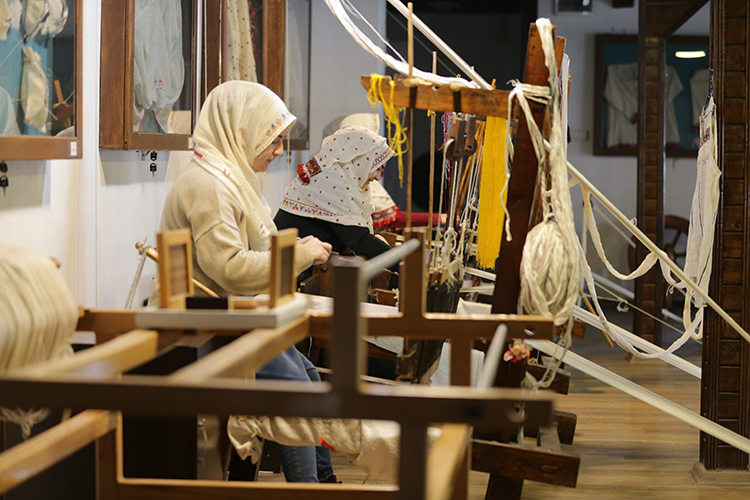Göynük Tokalı Örtme is a traditional woven textile product registered as a geographical indication (Registration No: 218), specific to the Göynük district of Bolu and its surrounding villages. The term “örtme” refers to a headscarf used for covering. This textile, formed by combining two pieces of fine cotton cloth, is distinguished by red tassels (“toka”) attached to its short edges. Produced in Göynük, where weaving has been practiced for centuries, the product was applied for registration on May 15, 2015, and was officially registered on September 18, 2017, under the category of “Designation of Origin.”
Structural and Technical Features
The headscarf comes in two standard sizes: 173 cm long and 92 cm wide (two 46 cm panels) or 200 cm long and 100 cm wide (two 50 cm panels). It is woven using the plain weave technique; warp and weft yarns consist of 20/1 Ne count, single-ply twisted cotton yarn (“kıvrak”), which gives the fabric a natural curl. The average weaving density is 20 warp × 20 weft threads per cm². The “toka” tassels that characterize the product are made of red orion thread and attached to the short edges after weaving. No color other than red may be used for these tassels.

Göynük Tokalı Örtme (Anadolu Agency)
Decoration and Motifs
The decorations of the headscarf are categorized into two main groups: “edge decorations” (on short sides) and “ground/forehead decorations.”
Edge Decorations
Motifs placed on the short sides are applied using a weft embroidery technique. Each motif is handcrafted using weft threads in different colors.
The main motifs include:
- Gayıklı baş (Kayık): A boat-shaped motif featuring an hourglass form within a tilted hexagon and eye motifs in the surrounding spaces.
- Göz (Eye): Concentric rhombus rings and quadruple dots in between.
- Kilim başı / Yarım kilim başı (Carpet Head / Half Carpet Head): A hexagonal frame surrounded by stepped triangles.
- Uzun baş (Tombstone): A large hexagon enclosing a rhombus and curved arms.
- Other motifs include makasçık (small scissors), kelebek (butterfly), gaydırak (slide), çaprazcık (hook), koyun gözü (sheep eye), and mekik baş (shuttle head).
Ground and Forehead Decorations
These decorations are applied using the brocade technique (supplementary weft insertion) along the long edges or at the center of the fabric. The most prominent motifs include goguk (wild tulip, V-shaped), para (coin, round or oval), kelebek (butterfly), and gaydırak (slide). The forehead motif is positioned exactly at the center of one of the long edges. The two long edges feature different designs: one is colorful (used in times of joy), while the other is plain (used in times of sorrow). This particular form of usage is unique to Göynük culture.
Color Palette
Background colors include shades of ecru, cream, and white; mustard color is strictly prohibited. Short edge borders have a maroon or dark red background. Patterns predominantly use white, green tones, yellow, red, navy blue, and black. Before the 1980s, dyed cotton or silk threads were used; with the introduction of orion threads, the color variety increased.
Production Method
- Loom and Materials: Produced on a two-legged wooden loom made of pine, called “düzen.” The loom components include the “tefe” (weft beater), “kücü” (warp separator), “selmin” (fabric rolling beam), and “ayakçak” (pedal).
- Weaving Preparation: Warp threads are sized using a mixture of wheat flour and water (1 kg flour and 20 liters water per 4 kg of yarn). This sizing gives the yarn strength.
- Weaving Process: After the warp is mounted, the weaver presses the pedals (ayakçak) to move the kücü and passes the weft thread through using a shuttle. Short-edge carpet patterns are woven with the kilim technique; colored motifs are added using the brocade technique.
- Tassel Attachment: The warp threads on the short edge are twisted to create double-layered fringes. Red orion thread tassels (3–3.5 cm in length) are then tied to these fringes.

Weaving Stage (Anadolu Agency)
Geographical Boundary and Inspection
All stages of production (weaving, motif design, tassel attachment) must be carried out within the boundaries of Göynük. Inspections are conducted at least twice a year by a committee composed of representatives from Göynük Public Education Center, the District Governorate, and the Chamber of Tradesmen and Artisans. The inspections examine yarn selection, motif accuracy, and adherence to standard production methods.
Cultural Significance
Tokalı Örtme is an integral part of Göynük’s cultural identity, reflecting its intangible heritage through its motifs and traditional weaving methods passed down through generations. The meanings attributed to motifs (such as emotional states) and the weaving techniques are unique to the region.


